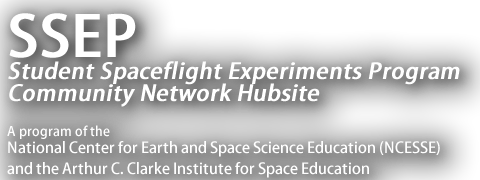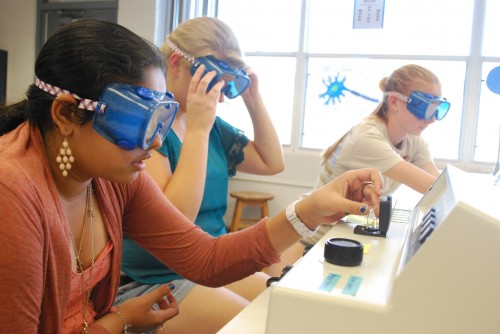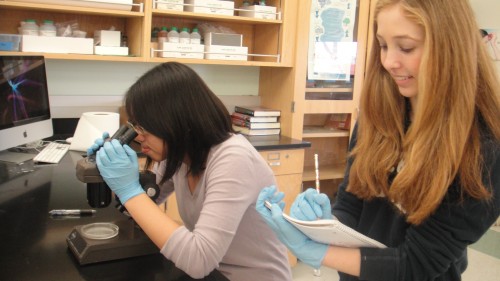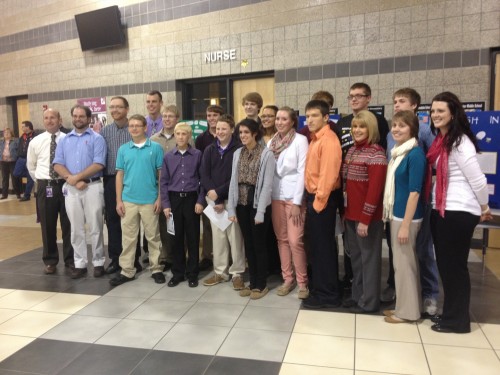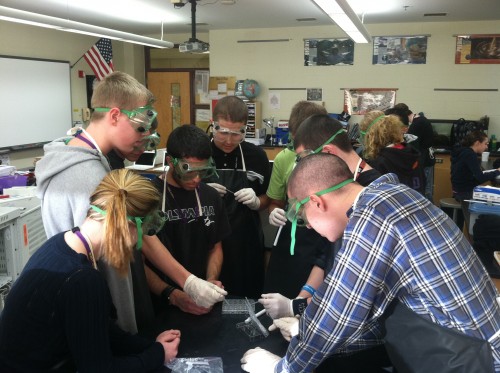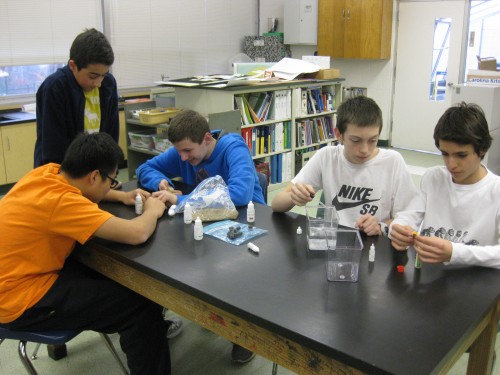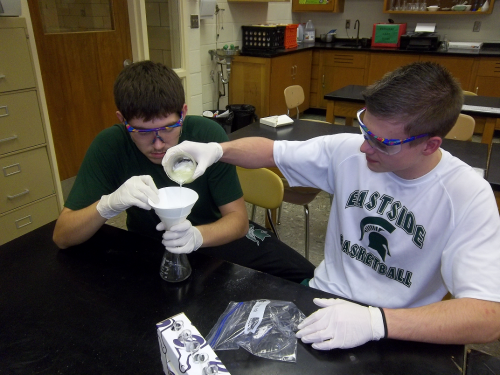Mission 3 Flight Operations Note: There are 17 flight experiments that comprise SSEP Mission 3 to ISS, reflecting the 17 participating communities. The experiments are described below.
5 experiments comprised the Mission 3a Falcon I payload, launched aboard Orb-D1, 10:58 am ET, September 18, 2013, from the Mid-Atlantic Regional Spaceport (MARS), Wallops Island, Virginia. These experiments returned to Earth on Soyuz 35S, landing in Kazakhstan on November 10, 2013.
12 experiments comprised the Mission 3b Falcon II payload, launched aboard Orb-1, 10:42 pm ET, January 9, 2014, from the Mid-Atlantic Regional Spaceport, Wallops Island, Virginia. These experiments returned to Earth on Soyuz 36S, landing in Kazakhstan on March 10, 2014.
The Mission (either 3a or 3b) associated with each community’s flight experiment is identified in green text below.
The Student Spaceflight Experiments Program is proud to report that there were a total of 1,466 proposals submitted from student teams across the 17 communities participating in Mission 3 to ISS—the greatest number of proposals received for a SSEP flight opportunity to date. Of those, 441 proposals were forwarded for review by Step 1 Review Boards in each of the communities. Each Step 1 Review Board selected three finalist proposals, which were submitted to the National SSEP Step 2 Review Board.
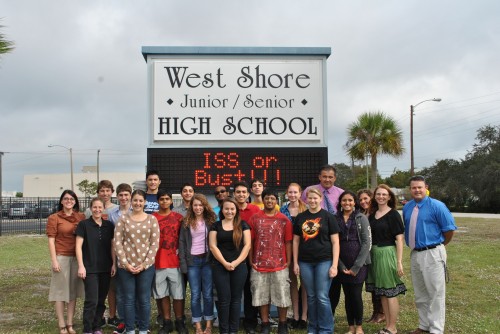
The sign says it all. SSEP student researchers at one of the 15 sites across the US comprising the Teachers in Space SSEP Community. (Click on Photo to Zoom)
On November 27-28, 2012, the Step 2 Review Board met at the Smithsonian’s National Air and Space Museum, reviewed all 51 finalist proposals, and selected one proposal to fly for each community, for a total of 17 flight experiments. It is noteworthy that the 1,466 proposals received reflected a total of 7,200 students fully engaged in experiment design.
All 51 finalist experiment teams, along with descriptions of their proposed flight experiments, are provided below. You are also invited to meet the SSEP Step 2 Review Board members for Mission 3 to ISS.
Congratulations to the over seven thousand students and their teachers participating in Student Spaceflight Experiments Program Mission 3 to the International Space Station.
1. Teachers in Space (TiS) Program, Space Frontier Foundation [Mission 3b]
Jump to the TiS Program’s Community Profile
SELECTED FOR FLIGHT:
A Study of How Microgravity Affects the Activity of Enzymes in Amyotrophic Lateral Sclerosis Using the Model of Papain and Gelatin
Grade 10-12, West Shore Junior/Senior High School, Brevard County Schools, FL
Co-Principal Investigators: Robert Edmiston, Jaclyn Martin, Harshit Saini, and Sanju Vardhan
Collaborators: Rashad Abdulla, Caleb Bryant, Olivia Escandell, Dave Foster, Anuj Mehindru, Krunal Patel, Luke Redito, and Carissa Sage
Teacher Facilitator: Amy McCormick, West Shore Junior/Senior High School
Proposal Summary:
This study is important to the researchers because one of the teachers at West Shore Junior/Senior High School, Jason Whitworth, was recently diagnosed with Amyotrophic Lateral Sclerosis (ALS). The researchers are investigating ways of better understanding the causes of ALS while raising awareness of the disease. It is the hope of the researchers to help patients suffering from ALS in their fight against this cruel degenerative disease.
Glutamate is an amino acid that acts as a neurotransmitter. The amount of glutamate that humans need is miniscule and is already manufactured by the body or obtained in whole foods. In the synaptic cleft between motor neurons, glutamate is normally deactivated and recycled by enzymes. In ALS patients, glutamate does not get broken down, but builds up to toxic levels, and eventually causes the neurons to die. As the neurons die, ALS patients lose control of voluntary muscles.
This experiment will serve as a model of the enzymatic breakdown of glutamate in the synapse. Because the actual systems require conditions not available on the International Space Station (ISS), a non-biological model was chosen. This experiment will test the effect of the enzyme papain (papaya extract) on the breakdown of proteins in gelatin by measuring the amount of protein remaining after the reaction. The aim of this experiment is to test the ability of an enzyme to function in microgravity. It is the hypothesis of the researchers that the enzyme will be able to function more effectively in a microgravity environment.
HONORABLE MENTION FINALISTS:
The Effect of Microgravity on the Spontaneous Differentiation of Mouse Embryonic Stem Cells
Grade 12, Bainbridge High School, Bainbridge Island School District #303, WA
Co-Principal Investigators: Ella Banyas, Mafalda Borges, Emma Gray, and Lydia Weyand
Teacher Facilitator: Enrique Chee, Physics Teacher, Science Department Chair, Bainbridge High School
Proposal Summary:
Imagine a cure for cancer. Such a discovery would benefit every single person on this planet, and the secret may lie within us all: stem cells. The potential medical applications of these unspecialized cells have been the cause of much speculation in the scientific community. However, scientists need to know more about the properties of stem cells in order to develop any possible uses. This experiment will contribute to such research by examining the effects of the microgravity environment on the spontaneous differentiation of embryonic stem cells. How will the cells react when introduced to a space environment? Will they develop more or less efficiently? In what ways will their development change? By answering these questions, we may be able to determine more about the biology of stem cells or the environmental conditions they need to grow. In light of the future of human space exploration, other potential benefits of our experiment concern space medicine, embryology, or reproduction in space. To conduct our experiment, we plan to culture two batches of mouse embryonic stem cells, one of which will be sent into space. Both cultures will spontaneously differentiate, with microgravity the only difference in experimental conditions. When the mission returns to Earth, we will analyze the pluripotency, survival rate, and differentiation of each culture to see how the space environment affected the mouse embryonic stem cells. Our results will add to the scientific community’s knowledge of stem cells and possibly prove influential in future medical research or space exploration.
Storage of Hydrogen in Carbon Nanotubes in Space
Grade 9-12, Mission San Jose High School, Fremont Unified School District, CA
Co- Principal Investigators: Aamir Rasheed, Charlie Tong, Jonathan Lu, and Patrick Zeng
Co-Investigators: Calvin Leung, Alan Shen, Andy Ko, and Sonia Li
Collaborators: Vikas Peddu, Damon Pham, and Ipsita Krishnamoorthy
Teacher Facilitator: Charles Brucker, Math Teacher, Mission San Jose High School
Proposal Summary:
Hydrogen fuel is one of many sources of energy that are being proposed to replace the polluting, nonrenewable petroleum based fuels used as an energy source during spaceflight, due to its relatively high energy density per unit mass ratio. However, the technical challenge of H2 storage has impeded the development of hydrogen as a practical energy source. Although currently proposed methods of storage, which include compressing and/or liquefying hydrogen, storing the hydrogen in metal hydrides, and adsorption, possess desirable characteristics, no approach satisfies all of the efficiency, cost and safety constraints for practical use, especially in spaceflight. The D.O.E. energy density goals for vehicular hydrogen storage call for systems capable of storing hydrogen at 6.5 wt % H2 and 62 kg H2/m3.
Experiments on earth conducted at Stanford University have found that for certain types of single-walled carbon nanotubes (SWCNT), the hydrogen chemisorption can provide more than 7 wt% of hydrogen storage capacity and the optimal C-H bond energetics can be tuned by the choice of the nanotube curvature range to minimize the energy losses of the hydrogen desorption/adsorption process.
We aim to recreate this experiment in space to determine whether the storage capacity of hydrogen in carbon nanotubes will change. We hypothesize that the storage capacity will increase because of less gravity-induced deformation of the SWCNT, which will affect the nanotubes’ optimal curvature.
2. Stonewall, Manitoba, Canada [Mission 3b]
Jump to Stonewall’s Community Profile
SELECTED FOR FLIGHT:
Will cosmic radiation increase the rate of mutations in yeast’s DNA? Will an antioxidant from green tea decrease the rate of mutations in DNA?
Grade 5, Brant Argyle School, Interlake School Division
Principal Investigator: Ethan Enns
Co-Investigators: Avery Good and Ryan Petricig
Teacher Facilitator: Leslie Nesbitt Fuerst, Teacher
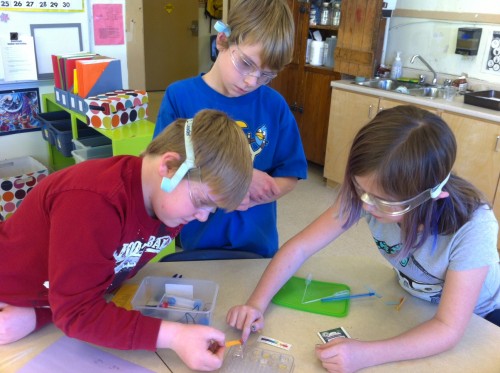
Ethan Enns, Avery Good, and Ryan Petricig testing the pH level of the antioxidant green tea for their experiment on Cancer cells.
Proposal Summary:
We want to know if astronauts can decrease their risk of cancer by taking an antioxidant supplement. Therefore, the question to be addressed by the experiment is:
Will cosmic radiation increase the rate of mutations in yeast’s DNA? Will an antioxidant from green tea decrease the rate of mutations in DNA?
We are using yeast because originally we wanted to test human cells in space but we found out that they would die before they got into space. The cells would not survive for several reasons: there is not enough oxygen, there would be no way to eliminate waste, there would not be enough nutrients, and it would not be warm enough. We will be using yeast as a model for human cells because they are very similar and easy to work with.
We will be testing yeast in saline and yeast in saline with an antioxidant from green tea to see if the antioxidant will protect the yeast from the cosmic radiation experienced in microgravity. On Earth we will have a control consisting of the exact same experiment. This will show us if there is an increased rate of damage to the yeast’s cells from the radiation and if the antioxidant will decrease the damage to the cells.
We hypothesize that the radiation will increase the rate of mutations in yeast’s DNA in space compared to the mutation rate on Earth. We also hypothesize that the antioxidant from green tea will decrease the mutations to yeast’s DNA.
HONORABLE MENTION FINALISTS:
Algae Growth in Microgravity
Grade 5, Woodlands Elementary, Interlake School Division
Principal Investigator: Hailey Friesen
Co-Investigator: Jennifer Fossay
Teacher Facilitator: Harold Enns, Science Teacher
Proposal Summary:
Our project is Algae growth in microgravity. Algae are tiny living things without roots or leaves. They are found in oceans, lakes, rivers, ponds, and wet soil. Some Algae can be only be seen through a microscope. Other algae are larger and made of many cells. It’s attached to weeds, rocks, and stones. There are brown, green, red, and, blue green colored algae. We think that algae could be used as a fuel source for cars, boats, houses, and rockets or space transport ships to other planets or the Moon. We think algae will grow faster in space because of microgravity. Algae have a very high percentage of oil. Algae can grow very fast. It takes about 300 hours to make a barrel or more full of algae. Algae can be a bio fuel for lots of heavy and light equipment. Algae can become some of the grain we use for some animals and feed them algae instead. Algae are the fastest growing plant on earth.
Honey Bee Raw Royal Jelly in Microgravity
Grade 6, Woodlands Elementary School, Interlake School Division
Principal Investigator: Grace Goodman
Co-Investigators: Laura Brad, Alex Chester, and Jordan Schott
Teacher Facilitator: Maria Nickel, Science teacher
Proposal Summary:
Our experiment is about honey bee raw Royal Jelly. The reason why we are doing this is we want to see if the effects of microgravity and cosmic radiation onboard the International Space station will speed up the loss of its nutritional value without being refrigerated or frozen. We hypothesize that it will and we would like to find out through this experiment if honey bee Royal Jelly can still be used as a nutritional food source for astronauts or osteoporosis patients on Earth. Through our findings we hope to learn that it will still be a valuable food source to help limit bone loss in these individuals. The scientific name for the honey bee is Apis mellifera. The Apis Mellifera produces milk called Royal Jelly that can help reduce many diseases or medical problems. Royal Jelly is necessary to queen bee production and survival. Royal Jelly can help treat osteoporosis by enhancing the body’s ability to absorb the calcium and deposit it in the bone structure, reduce high cholesterol, high blood pressure, and reduce heart disease. Bees are a critical pollinator for crop production on Earth. Without bees, food production would be significantly reduced. If humans ever move from Earth to live for extended time periods in space, such as a Moon base or Mars space colony, bees could be crucial to human survival there as well as on Earth. Not only as a possible treatment for osteoporosis but also as a continuation of food production on Mars or the Moon.
3. San Marino, California [Mission 3a]
Jump to San Marino’s Community Profile
SELECTED FOR FLIGHT:
Fibroblast Division in Microgravity
Grade 11, San Marino High School
Co-Principal Investigators: Jennifer Jiang, Jasmine Kuo, and Kara Lukas
Teacher Facilitator: Wyeth Collo, Science Department Chairman, Biology Instructor
Proposal Summary:
Cell division is an integral component of life; all organisms must go through the cell cycle in order to grow, develop, and reproduce. Past experiments that have been conducted on Earth in simulated microgravity have shown that the lack of gravity causes cells to divide at a slower rate. We have decided to conduct further research concerning this topic and perform an experiment which will hopefully yield favorable results for science and humankind. The purpose of our experiment is to observe the effect of microgravity on cell division and to compare the rates of cell division in the absence and presence of gravity, which is dependent on the number of cells produced. The cells that we have chosen to experiment with are fibroblasts, which play a critical role in the healing of wounds. To test our experiment, the fibroblasts will be exposed to microgravity as they grow and proliferate; simultaneously, two identical experiments will be held on Earth to serve as a control. After the experiment has run its course, it will be brought back to us for analysis where we will compare the results with those of the control experiments. With the data from our experiment, we hope to improve the conditions of future life in space as well as to further our current scientific knowledge.
HONORABLE MENTION FINALISTS:
The Effect of Zero Gravity on Anabolic and Catabolic Bone Growth Factors
Grade 9-10, San Marino High School
Co-Principal Investigators: Diana Felix and Marina Felix
Teacher Facilitator: Wyeth Collo, Science Department Chairman, Biology Instructor
Proposal Summary:
It is well known that astronauts, when exposed to zero gravity, will lose bone mass. Prolonged exposure to zero gravity may threaten the health and safety of space explorers. Understanding the mechanisms of bone loss in space may lead to interventional therapeutic strategies that could reduce or even eliminate bone loss in space travelers. Loss of bone may occur via two mechanisms; increased bone loss (catabolism) or decreased bone formation (anabolism). Markers of bone anabolism and catabolism have been well described. This experiment attempts to determine if bone exposed to zero gravity will experience increased catabolism, decreased anabolism or both, and to what extent each mechanism may influence bone loss. Similar samples of bone will be placed in identical experimental test tubes under the same experimental conditions. One tube will travel to the International Space Station while the other will remain on Earth. After a 48-hour exposure, the experiment will be arrested with RNA later (a preservative of mRNA) and samples analyzed for 2 anabolic and 2 catabolic factors of bone growth using the real-time reverse transcriptase polymerase chain reaction technique. Resulting data is expected to clarify which mechanism, decreased anabolism versus increased catabolism, is preferentially responsible for bone loss during zero gravity exposure.
The Effects of Microgravity on Enantiomer Production
Grade 10, San Marino High School
Co-Principal Investigators: Girish Balaji, Kavi Gupta, John Judge, Chance Kuo, and Nathaniel Rolfe
Co-Investigators: Janakirama Kalidhindi, Rachel Linton, and Richmund Tan
Collaborator: Ming Cao
Teacher Facilitator: Wyeth Collo, Science Department Chairman, Biology Instructor
Proposal Summary:
In this experiment, our group is investigating the differences in enantiomer production in microgravity compared to that on Earth. The two forms of enantiomers, mirror-image molecules with identical molecular formulas, are referred to as levorotatory (L) and dextrorotatory (D). Enantiomers are present in many pharmaceutical drugs and supplements, in which the L form often binds effectively to target receptors while D is typically biologically inactive or even harmful. Our experiment will test for differences between L and D enantiomeric ratios produced biologically in microgravity versus those under the influence of Earth’s gravity. We will test the ratio of L to D amino acids, all of which are enantiomeric with the exception of glycine. If the ratio is measured at higher concentrations of L in microgravity than on Earth, biological processes for creating drugs would be more efficient in microgravity. On the other hand, if the ratio is measured at higher concentrations of D in microgravity, then those same methods of drug production would be less efficient in microgravity and would need to be altered. By testing the effect of microgravity on the enantiomeric ratios of amino acids, we can reveal any differences in microgravity enantiomer production that drug manufacturers should take into account. Some drugs are manufactured by genetically modified bacteria. For this reason, our proposed experiment will utilize Lactobacillus plantarum grown in space as well as on Earth; we will isolate the bacterial proteomes of both for comparison of enantiomeric ratios.
4. Washington, DC – Capitol Hill Cluster of Schools [Mission 3b]
Jump to Washington DC’s Community Profile
SELECTED FOR FLIGHT:
Bacterial Growth on Meat
Grade 7, Capitol Hill Cluster School, District of Columbia Public Schools
Co-Principal Investigators: Lillian Bassow, Sarah Carleton, Cameron Gray, and Lia Johnson
Teacher Facilitators: Doug Creef, Science Teacher; Richard Munz, Technology Teacher
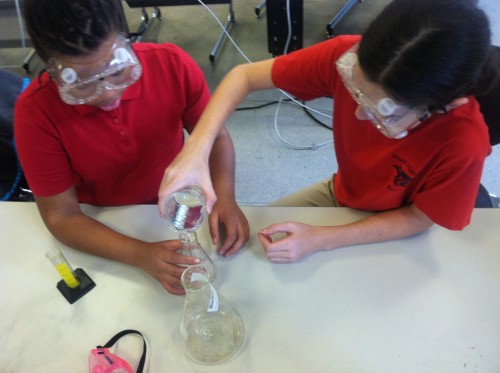
Lilly and Cameron test saline solutions in the lab at Stuart Hobson Middle School.
Proposal Summary:
Our proposed experiment is to test the preserving properties of salt on meat in microgravity. We developed this experiment based on our knowledge of how food was preserved in the past. Salt was used to prevent bacterial growth and preserve meat for an extended period. This experiment could shed light on alternatives to freeze- dried food for astronauts and visitors to outer space. The experiment consists of a piece of unsalted meat and a piece of salted meat. The unsalted meat will test to see if bacteria will grow on the meat in microgravity. The salted meat will test to see if, should bacteria grow on the meat, salt will mitigate bacterial growth in microgravity.
HONORABLE MENTION FINALISTS:
Chemical Changes in Microgravity
Grade 7, Capitol Hill Cluster School, District of Columbia Public Schools
Co-Principal Investigators: Lillian David Brewer, Nicholas Pehrson, and Abraham Scofield
Teacher Facilitators: Doug Creef, Science Teacher; Richard Munz, Technology Teacher
Proposal Summary:
We want to send gel glue and a borax and distilled water solution to the International Space Station and mix them there to study how chemical changes occur in microgravity. When gel glue and borax are mixed they make a rubbery, bouncy slime. We want to see if the zero gravity will affect the formation of the slime. When made on earth, the slime will form by the ingredients touching each other, without being kneaded; the gel glue absorbs the borax and solidifies. We want to see if the slime is formed at all or forms differently if the ingredients re combined in microgravity. If the borax and glue are still separated or form a different slime than the one formed on Earth when the project comes back, then the microgravity did affect the formation of the slime. When the mixture comes back to earth, we will see how it differs to one formed on earth.
Sediments in Space
Grade 6, Capitol Hill Cluster School, District of Columbia Public Schools
Co-Principal Investigators: Liza Engman, Margaret Meinhardt, Niamh Nolan, and Nora Ripley-Grant
Teacher Facilitators: Susan Mitchell-Dunn, Science Teacher; Richard Munz, Technology Teacher
Proposal Summary:
Based on our knowledge of how sediment forms in watery environments we know that heavier sediments sink to the bottom and lighter sediments stay near the top of the sediment pile. We want to test how sediment forms in a microgravity environment, since gravity is a major factor in how sediment forms on Earth. Our experiment will include materials commonly found in sediment on Earth: dry leaves, clay powder, water, and sand. This knowledge will help us understand how sediment forms in a microgravity environment, in orbit or on smaller planets and moons.
5. Hilo/Waiakea, Hawai’i [Mission 3b]
jump to Hilo’s Community Profile
SELECTED FOR FLIGHT:
Does microgravity affect the growth of a Glycine max seed?
Grade 6, Waiakea Intermediate School
Principal Investigator: Josh Ebesugawa
Teacher Facilitator: Gregg Yonemori, Science Teacher
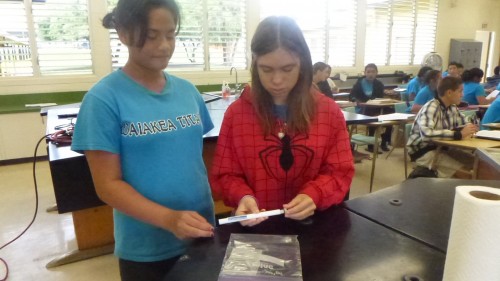
Two students from Tabitha Booth’s eighth grade class at Waiakea Intermediate School, Rachel Hu and Kaila Joy Mahoe, explore the FME minilab for the first time.
Proposal Summary:
This experiment will attempt to determine if microgravity affects the growth of a Glycine max seed. The experiment uses deionized water, sterilized soil, fertilizer, and dry Glycine max seeds. Equal parts of sterilized soil and fertilizer will be mixed. The nano rack will be filled with 4 mL of the soil and fertilizer mixture. Three approximately 1.5 mL dry Glycine max seeds will be weighed separately and placed in the center of the soil and fertilizer mixture. Weight of each seed will be recorded. Ampoules A and B will each be filled with .92 mL of deionized water then placed in the nano rack. Two days after the space shuttle arrives at the space station, Ampoule A will be broken releasing water onto the contents of the nano rack. The same process will be done fourteen days before departure back to earth. The same experiment will be simultaneously conducted on earth. Upon return of the space shuttle, observations of the seeds will be done and data will be collected. Observations will include seed weight, length of any cotyledon, and stage of growth. This experiment will be conducted to determine if microgravity affects seed growth. If it is determined that microgravity allows for seed growth, plants can be grown in space as a renewable food source. These plants will also recycle carbon dioxide and release oxygen. Food supplies will be less of an issue. Space travelers will be able to travel farther in the solar system and live in space stations for longer periods of time.
HONORABLE MENTION FINALISTS:
How Does Microgravity Effect Basil’s growth?
Grade 8, How Does Microgravity Effect Basil’s growth?
Principal Investigator: Jacqueline Millard
Co-Investigators: Jodi Go and Auli’i Maeda
Teacher Facilitator: Tabitha Booth, Science Teacher
Proposal Summary:
This experiment would like to see how Basil’s growth will be affected by microgravity. Basil serves for many purposes on Earth and we’d like to see if Basil could germinate in space and then be grown on the Moon or Mars. For this experiment we will be using a type 3 FME, which consists of a Main Volume, Short Ampoule A, and B. In the Main Volume there will be 4mL of a soil mixture consisting of egg shells, Mauna Kea soil, along with 2mL of tap water and 3 Basil seeds. Each Short Ampoule has 0.90mL of tap water. The Basil plants will be given water in increments so they don’t drown nor die of thirst. When the FME is at the ISS, a simultaneous experiment will be conducted on Earth. Following the arrival of the FME from space, observations will be made to compare the distinctiveness of the space and Earth Basil plants. After our analysis, we will plant every basil seed in the ground and record the height growth each week to calculate a rate of development. This study is important because it may back up results from past trials and the information gathered can help scientists figure out a way to grow plants in space.
Can earthworms survive in space and what is their reaction to microgravity?
Grades 8, Waiakea Intennediate School
Principal Investigator: Jace Nagao
Co-Investigators: Shaun Kojima and Kien Uyeda
Collaborator: Wesley Amuimuia
Teacher Facilitator: Tabitha Booth, Science Teacher
Proposal Summary:
Earthworms are tube-shaped, segmented animals and are decomposers. They are mostly found living in the soil and are very good for composts since they take in the food scraps, coffee grounds, etc. and turn it into new soil for gardens. They are also edible raw but you would have to eat it with another food so you don’t gross out from the texture and flavor. You won’t get sick from the dirt in the worm because your immune system will fight it off. We want to see if earthworms can survive in space, meaning that they can still produce new soil from food scraps and dead or decayed animals/plants and still stay alive. We also want to see what the worm’s reaction is when it’s in microgravity. For example, the worm could move slower, stay still or frozen (play dead), move quicker, etc. This could even affect the speed that the worm decomposes dead or decayed animals/plants into new, rich soil. So, we basically want to find out if earthworms can decompose and/or stay alive after being in micro gravity, and the reactions of the earthworm after being in space with little gravity. We hope to find out if there’s a chance that decomposing things in space is possible. This could also find out if worms can help us have life on Mars by eating the fecal matter and producing soil.
6. Valley Center, Kansas [Mission 3b]
Jump to Valley Center’s Community Profile
SELECTED FOR FLIGHT:
The Effect of Microgravity on Bacterial Growth and its Resistance to Antibiotics
Grade 10 and 11, Valley Center High School
Co-Principal Investigators: Garrett Chandler, Wesley Crow, and Cole Klinkhammer
Co-Investigators: Logan Burks and Samuel Sheahan
Teacher Facilitator: Jeff Tracy, Science Teacher
Proposal Summary:
We know that bacteria grown in space are more virulent, but does it make them resistant to antibiotics? The essential purpose of our experiment is to monitor the effect of microgravity on the growth of bacteria and how it resists an antibiotic originally used to eliminate the bacteria grown in the effect of gravity. Using FME Type 3 we will be able to control when each “ingredient” is added to the experiment. This should allow for precise results. Following its return the FME will be sent to Valley Center High School for analysis. Our bacteria, staphylococcus intermedius is a very common bacteria that can cause multiple harmful infections. The antibiotic of our choice is ciprofloxacin which is considered a good to excellent killer of these specific bacteria.
HONORABLE MENTION FINALISTS:
Nothobranchius Guentheri Killifish in Microgravity
Grade 12, Valley Center High School
Co-Principal Investigators: Demian Ahrendt, Madison Anderson, Joel Blankenship, Taylor Cummings, and Josh Ortiz
Teacher Facilitator: Kristen Joyal, Mathematics Instructor
Proposal Summary:
The purpose of this experiment is to determine whether the survival and growth rates of killifish hatched in microgravity differ from those hatched on Earth. Will the microgravity climate of space affect how the fish develop and grow? Killifish eggs were selected for this experiment because their diapause state can be predicted and easily controlled. In nature they live in ponds that annually dry up but the species continues to survive because the eggs lay dormant in diapause until the rainfall comes back and stimulates growth. This experiment will hatch eggs in space and here on Earth in conditions that are comparable besides the microgravity aspect. Once they return back to earth, the plan is to measure the initial differences in hatching rates, size of the fish, and how their swim patterns differ once introduced back into the Earth’s gravity. Long term study of the fish will include a comparison of growth rates, reproduction and lifespan of the fish hatched in microgravity compared to the control group.
Effect of Microgravity on the Process of Mitosis
Grade 10 and 11, Valley Center High School
Co-Principal Investigators: Laramie Unruh and Travis Wiederstein
Co-Investigators: Audrey Ricks and Alayna Samia
Teacher Facilitator: Jeff Tracy, Science Teacher
Proposal Summary:
In this experiment, we will be using raphanus sativus, commonly known as the cherry belle radish, to test the process of mitosis in microgravity. To do this, we will contain the seeds inside the first small ampoule along with a small amount of cotton on one end of the ampoule to contain the growth of the seeds.The main body will contain water to start the growth process of the seeds. The roots of the raphanus sativus typically develop around seven days after the germination process starts. So, fourteen days before departure the first ampoule will be broken to start the germination process in both the control sample and the experimental sample. Five days before departure, the second ampoule containing the inhibitor will pause the growth of the raphanus sativus. When the sample is returned, both the ground experiment and the space experiment will be examined under a microscope. The length of the roots, as well as the number of cells in each stage of mitosis will be recorded. By juxtaposing the two samples, we will be able to determine if gravity has an effect on mitosis.
7. Howard County, Maryland [Mission 3a]
Jump to Howard County’s Community Profile
SELECTED FOR FLIGHT:
The Effect of Microgravity on Chryseobacterium Aquaticum Growth
Grade 8, Lime Kiln Middle School
Co-Principal Investigators: Gregory Nelson and Josh Choi
Co-Investigators: Sophia Novacic and Ryan Olsen
Teacher Facilitators: Ella Jordan and Lauren Landerman, Science Teachers
Proposal Summary:
What makes our experimental proposal different from the hundreds of bacteria experiments already done in space? We already know that bacteria have been proven to grow faster in microgravity and much more. What else do we need to learn? Chryseobacterium aquaticum is unique because of its features that allow it to live under harsh living conditions on Earth. It may be beneficial to future deep space explorations, as it produces an anti-fungal protease and enzymes that may encourage plant growth. (Ghandi Pragash M, Narayanan KB, Naik PR, Sakthiven N, 1/19/2009). Thus, we propose the following “does Chryseobacterium aquaticum grow in microgravity.” Our hypothesis is that if Chryseobacterium aquaticum is put in a microgravity enviroment then it will grow faster because past experiments have shown bacteria grow more efficiently in space. Our experiment will use a type three fluid mixture enclosure (FME). The materials we will need are a pure culture of Chryseobacterium aquaticum, Nutrient Broth, and Formalin. When Nutrient Agar and Chryseobacterium aquaticum are mixed it will start the growing process. The formalin is then added halting all growth will. Next we will count the amount of bacterial colonies giving us an accurate analysis of the growth of Chryseobacterium aquaticum. We hope this knowledge will aid astronauts in future space exploration.
HONORABLE MENTION FINALISTS:
Copepod Growth in Microgravity
Grade 8, Wilde Lake Middle School
Co-Principal Investigators: Cyrus Jenkins and Calvin Kuang
Teacher Facilitators: Damisha Drakes and Douglas Spicher, Science Teachers
Proposal Summary:
Our SSEP proposal is to see how copepod growth is affected in micro gravity. We are doing this because copepods are the base of many food chains and if they can survive, then other life may be able to as well. If this works, humanity may be able to create entire ecosystems in space and perhaps retrieve food from fish farms and such. Not to mention we will also be able to possible generate oxygen in the depths of space. Copepods are a type of zooplankton and their diet includes microscopic algae, diatoms, and bacteria. In space, we plan to keep them alive by putting algae in ampoules and having the astronaut break those ampoules in order to feed the copepods. Once the copepods return to Earth, we will analyze their growth as well as how many of them remain. Then, we will compare these test results to those we’ve gathered on Earth.
Zinc-Insulin Crystals in Microgravity
Grade 8, Hammond Middle School
Co-Principal Investigators: Victoria Airapetian, Alicia Borges, and Alex Sadzewicz
Teacher Facilitator: Christopher Doody, science teacher
Proposal Summary:
Protein crystals are a three dimensional collection of molecules and are included in many diseases, making them essential parts of organisms. For our experiment, we want to send zinc- insulin hexamer into space in a FME Type 2 in the condition of microgravity to grow protein crystals. The goal for this experiment is to find new occurring data about insulin protein crystals for diabetes. If insulin is purer, then there is a chance that the insulin has more effect on diabetics. Our prediction of what would happen to the protein crystals in the conditions of microgravity is that the crystals will grow larger and be more pure than those on Earth because this process cannot be achieved in Earth’s environmental conditions. When our experiment comes back to Earth, we will use a fluorescent microscope provided by the University of Maryland to observe the data from the crystals. We will do this by measuring and comparing the size, mass, and molecular structure of the crystals grown in microgravity. We will use a triple beam balance to measure the mass, and we will use a microscope or an x- ray diffraction machine.
8. Fitchburg, Massachusetts [Mission 3b]
Jump to Fitchburg’s Community Profile
SELECTED FOR FLIGHT:
Will Microgravity Alter the Regeneration of Dugesia Tigrina?
Grade 10 and 12, Montachusett Regional Vocational Technical School
Co-Principal Investigators: Chris Jerszyk, Ryan Perenzin, Nick Wicker, and John Wheeler
Co-Investigators: Matthew Elsevier, Brian King, Adrienne LaRoche, and Jack Marabello
Teacher Facilitator: Paula deDiego, Chemistry Instructor
Proposal Summary:
Our experiment proposal is focused toward a concept of regeneration. In this case, what
is the effect of microgravity on the regeneration of an organism that is genetically similar to human beings, D. Tigrinas? D. Tigrinas and humans both regenerate cells in a similar way, pluripotent stem cells. Because pluripotent stem cells can specialize into any type of cell in an organism, discovering how these cells work has great potential in the medical field for treatments and cures to diseases that as of yet have no cure. D. Tigrinas have the capability of regenerating entirely new bodies from severed body parts using the pluripotent stem cells found in their bodies. In accordance with this fact, our experiment will be to cut a D. Tigrina halfway down in order to observe the effect microgravity has on the regeneration or healing of the D. Tigrina. We hypothesize that in microgravity the D. Tigrinas will regenerate in a much larger volume than under normal conditions due to the lessened amount of force acting upon the new cells. Also, we believe that the lack of gravity will throw off the D. Tigrinas sense of equilibrium, which could mean that the new body structures formed might have structural defects as well.
HONORABLE MENTION FINALISTS:
The Effects of Microgravity on Mutations in MRSA
Grade 11, Montachusett Regional Vocational Technical School
Co-Principal Investigators: Melissa Franz, Zoë Frati, Breanna Nadeau, and Selena Santiago
Collaborator: Justin King
Teacher Facilitator: Paula deDiego, Chemistry Instructor
Proposal Summary:
Methicillin-resistant Staphylococcus aureus (MRSA) is found on Earth. Our proposal is to see the effects of the mutation of the genes. The way that MRSA mutates could be different in microgravity. To determine our theory we will use nutrients including 50mL of defibrillated sheep blood, tryptic soy agar 40g, and DI water 950mL in one tube. Another tube will contain the bacteria (MRSA). The will perform the experiment by cracking the tubes so the nutrients and the bacteria mix together to begin growing. When it arrives back we will send the bacteria to a microbiologist to perform a genome test, from this the results will be determined. Based on the results, we will be able to determine if the genes are affected differently in microgravity than on Earth. We will also determine if the DNA has mutated into a stronger strand than on Earth. When it mutates the genome changes and a letter changes in the DNA strand. A penicillin binding protein caused by a mobile genetic element caused the mutation on Earth. MGE is a type of genetic material that has the ability to move genetic material from one organism to another. The toxin mecA is located in the DNA strand of MRSA where the mgA is bonded together with the DNA strand. The gene has continued to evolve and this is why many MRSA strands are resistant. We will be testing to see if the genes have mutated in more than one spot.
Will Microgravity Establish Any Substantial Changes to the Oxyglobin Molecule?
Grade 11 and 12, Montachusett Regional Vocational Technical School
Co-Principal Investigators: Olivia Frawley and Spencer Uguccioni
Collaborators: Brooke Alexander and Nadia Machado
Teacher Facilitator: Paula deDiego, Chemistry Instructor
Proposal Summary:
The purpose of our experiment is to determine if the Oxyglobin blood substitute functions differently than it does in Earth’s atmosphere when exposed to microgravity. Oxyglobin is a synthetic bovine hemoglobin molecule capable of treating hemotologic diseases in the veterinary market. To date, its oxygen passing capabilities are quite satisfying due to the molecule’s small size and ability to pass through tissues. However, since it is not as significant as real iron-containing red blood cells in the process of delivering oxygen to the tissues of the body, our experiment’s purpose is to determine if microgravity can improve this technique and help save animals from common fatal diseases such as anemia. Our experiment is a supplement to a previous experiment revolving around a similar topic: “Will Microgravity Have a Significant Effect on Packed Synthetic Hemoglobin Based Oxygen Carriers (HBOC’s)?” The preceding experiment used Hemopure, a synthetic blood substitute approved in Russia for human use. We will be looking at Oxyglobin, an HBOC similar to Hemopure, to gain more information on the effect of microgravity on HBOC’s. As a team, we will pack two blood samples. One of the two will be staying on Earth for comparison and analysis after the flight. We will use both for a series of tests to determine the impact of microgravity and the changes between the two samples.
9. Traverse City, Michigan [Mission 3b]
Jump to Traverse City’s Community Profile
SELECTED FOR FLIGHT:
How do growth and antibiotic use together respond in microgravity?
Grade 10, Traverse City West Senior High School
Co-Principal Investigators: Haley Dole, Paxton Ellul, and Ashley Miller
Teacher Facilitator: Patrick Gillespie, Science Teacher
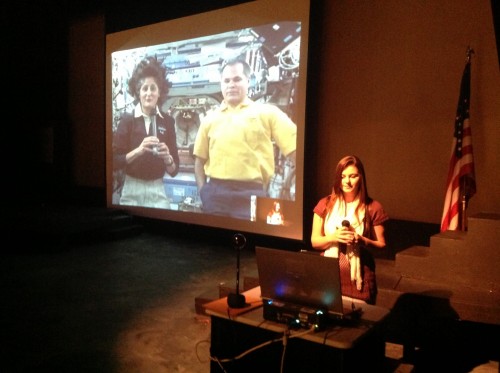
On November 15, 2012, during a live video-conference with the International Space Station, Traverse City West Senior High School 11th grade SSEP researcher Kelsey Cosens asks Station Commander Sunita Williams and astronaut Kevin Ford a question. Over 12,400 participated in the live event across 25 SSEP communities.
Proposal Summary:
Everyone all around the world is exposed to numerous amounts of bacteria. Bacteria can lead to infections and deadly illnesses. Because of modern medicines and cleaning agents people on Earth have made it harder to become infected with bad bacteria and can cure infections. When astronauts travel to space there are no washing machine for clothes, no hospital, limited cleaning supplies, limited water, and limited amounts antibiotics for treating bacteria. Astronauts are exposed to many bacteria, the chances of getting infections are higher, and it is dangerous without the right antibiotic treatment. When a bacterium infects the skin is grows exponentially so it is important to treat it with an antibiotic right away especially in space where there is no hospital. To protect astronauts from bacteria we will test the strength of an antibiotic (cephalexin) on a skin bacterium (staphylococcus epidermidis) in a microgravity environment. The bacteria Staphylococcus Epidermidis is exposed easily to people because it lives on skin and but it causes dangerous infections. It starts small in a cut or sore then grows in the flesh. This is why its important for people to know how antibiotics work in a microgravity environment before someone is exposed to a bacterium such as Staphylococcus Epidermidis and its not treated correctly. After our experiment where we will expose our bacterium to the cephalexin we will compare the surviving bacteria cultures with our control experiment on Earth in Munson’s laboratory. This will show how efficient antibiotics are in a microgravity environment.
HONORABLE MENTION FINALISTS:
Facultative Anaerobic Bacteria Growing and Being Killed in Space
Grade 10, Traverse City West Senior High School
Principal Investigator: Kelly O’Hara
Co-Investigators: Sarah Bobier, Taylor Kehoe, and Taylor Witkop
Collaborators: Emily Cybak and Kenneth Ponce
Teacher Facilitator: Patrick Gillespie, Science Teacher
Proposal Summary:
Our group has decided to send a bacteria called Bacillus Subtilis into space. This bacteria is a facultative anaerobe meaning it can live and grow with or without oxygen. We are getting this bacteria from Carolina Biological Supply Company in a freeze dried vial. Bacillus Subtilis is found in soil of decomposing organic matter. If we deliver this type of bacteria to a planet we are visiting and have no way of killing it the bacteria would alter the planet’s biosphere. To make this bacteria generate and grow we simply add water. For two weeks we are letting the bacteria grow in space. Then, we will have the astronauts add household chlorine bleach to the bacteria in an oxygen free environment. Chlorine bleach is the number one way to kill this bacteria on earth. Here in Traverse City we are having a lab specialist at Mercy Hospital in Grayling, Michigan, measure the exact amount of bacteria from the experiment that went into space and the control ground experiment. This way we can see the difference in growth rate between. Our main goal is to see is if the Bacillus Subtilis rate of growth is any different in space,
and/or if the chlorine bleach will kill the bacteria while in space.
Bacterial Growth in Microgravity
Grade 10, Traverse City West Senior High School
Co-Principal Investigators: Lynn Doherty, Kasey Niedermaier, Andrea Nielsen, and Abigail Thompson
Teacher Facilitator: Patrick Gillespie, Science Teacher
Proposal Summary:
We are proposing to test the growth of Escherichia Coli B in microgravity. We want to use the 3 FME (3 experiment volumes: Main Volume, Short Ampoule A, Short Ampoule B) to monitor whether or not E. Coli grows faster in microgravity or on Earth. When the experiment arrives at the Space Station, the short ampoule A, containing the E. Coli, will be broken open and will be mixed with the hydrating fluid in the FME main volume. Here on Earth, we will break open the short ampoule A at the same time. A day later the short ampoule B, with the nutrient agar, will be broken open to mix with the E. Coli and re-hydration fluid. At the same time we will break open the short ampoule B on Earth. When the experiment performed in the Space Station returns, we will compare the results from microgravity with the ones from our experiment performed on Earth. We have found a laboratory, SOS Analytical (946-6767) that would be able to measure the E. Coli growth if our experiment were to be chosen.
10. Pleasanton and Callaway, Nebraska [Mission 3b]
Jump to Pleasanton and Callaway’s Community Profile
SELECTED FOR FLIGHT:
Kidney Stone Growth in Space
Grade 11, Pleasanton Public School
Principal Investigator: Kara Dauel
Collaborator: Breann Zimmer
Teacher Facilitator: Alison Buescher, Grade 7-12 Science Educator
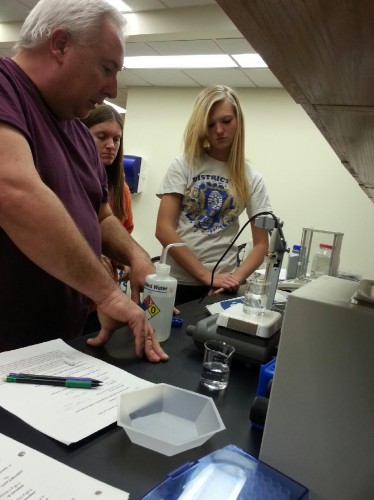
Pleasanton Students Breann Zimmer and Kara Dauel work with local researcher, Dr. Frank Kovacs, Biochemistry professor at the University of Nebraska-Kearney. The student research team is calibrating a pH sensor to determine the pH levels of the experimental solution.
Proposal Summary:
Kidney stones are a very common medical condition. Everyone is susceptible to kidney stones if they don’t drink enough water. NASA researchers have found that there has been an increase of kidney stone formation in astronauts during space flight (A Potential Cause). We want to test how microgravity affects formation of calcium oxalate crystals in space. We also want to see if more kidney stones form in microgravity than on Earth and identify distinguishing growth characteristics between the two environments. We hope this research will help scientists find a way to decrease the formation of kidney stones in microgravity.
HONORABLE MENTION FINALISTS:
The Effect of Microgravity on the Anatomy of Daphnia
Grade 12, Pleasanton Public School
Principal Investigator: Kayla Linden
Collaborators: Jenna Martin, Dalton Hand, Alex Johnsey, and Mariah Zwiener
Teacher Facilitator: Alison Buescher, Grade 7-12 Science Educator
Proposal Summary:
For our experiment, we have chosen to use daphnia, a clear-bodied crustacean commonly referred to under the broad term “water flea”. Their see-through bodies make studying the internal organs much simpler because they do not require dissection. Our mission is to study microgravity’s effect on the heart, brain, exoskeleton, abdominal setae, and antennae. These features are identifying structures unique to specific species, so any changes will be comparable with the control experiment. To view all details, we will be using a digital microscope. We hope that our findings will be useful to the health of humans who spend an extended amount of time in space.
Difference of Density in Brine Shrimp Exoskeleton
Grade 11, Pleasanton Public School
Principal Investigator: Micky Ahrens
Collaborators: Anthony Hill and Josh Roe
Teacher Facilitator: Alison Buescher, Grade 7-12 Science Educator
Proposal Summary:
While in space it has become a common occurrence to notice difference in length of the body and reduction in bone density. This change can cause severe health problems for astronauts coming back to earth. Brine shrimps exoskeletal system are clear examples of bone structure. Due to the fast paced life-span of the Brine shrimp this makes them ideal for studying change during growth. By studying the growth of the exoskeletal system of our new-born brine shrimp will aid us in finding a counteractant to the problems we may be encounter in the near future.
11. Alpine, New Jersey [Mission 3a]
Jump to Alpine’s Community Profile
SELECTED FOR FLIGHT:
What is the effect of farming in microgravity using hydroponics, and how is it different from plants grown on Earth using the same method?
Grade 8, Alpine Public School
Co-Principal Investigators: Alec Aljian and Jude Zeino
Co-Investigators: Paul Greenway, Adam Koby, and Paul Yoon
Teacher Facilitator: Rivka Rosenstein, Alpine School Science Teacher
Proposal Summary:
One pound of food can cost thousands to send into space; with several hungry astronauts, dining can become rather expensive. Food has to be produced on Earth, processed, freeze-dried and sent to the International Space Station (ISS). By using hydroponics, the method of growing plants in a nutrient solution instead of soil, we can hopefully find a way to grow crops in microgravity, lessening this cost and providing fresh food. We will be using the type two Fluid Mixing Enclosure (FME), and inserting a lentil seed enclosed in porous foam in the main volume along with hydroponic growth solution contained in the long ampule. We believe that the seed will germinate under microgravity, and our group shall observe the specimen’s xylem, phloem, and other structural characteristics. On Earth, this process relies heavily on gravitropism, which “tells” a plant the direction in which its root and stem should grow. If our experiment proves to be successful, it may lead to the dawn of farming in space. Hopefully, shipping food to the ISS will become a thing of the past.
HONORABLE MENTION FINALISTS:
The Formation of Copper Sulfate Crystals in Microgravity
Grade 8, Alpine Public School
Co-Principal Investigators: Jillian Arzoomanian, Chelsea Glasser, and Melissa Hoffmann
Co-Investigators: Susan Distler and Samantha Simotas
Teacher Facilitator: Rivka Rosenstein, Alpine School Science Teacher
Proposal Summary:
It is common knowledge that crystals are a geometrical solid, with an eye catching lattice pattern that start out as a liquid, and evaporate into a solid. To create copper sulfate crystals, reorganization of the atoms that make up copper sulfate must occur between distilled water and copper sulfate (CuSO4.5H2O). Therefore, we want to initiate an experiment on the formation of these blue, rhombus-shaped crystals (see Figure 3) in microgravity. Our objective is to compare the characteristics of crystals on Earth to the ones developed in space. We hypothesize that these crystals will develop, but will be geometrically different than the crystals formed on Earth. Testing out this experiment, we found that these beautiful crystals can be created without sunlight in a test tube. Used in real life, copper sulfate can act as an algaecide to remove fungi and bacterial diseases from fruit and vegetable crops. This element is naturally occurring in plant and animal tissue.When the FME returns from space we will compare the characteristics between the two experiments. We will compare the color and shape. Predicting that these crystals will come back developed from space, we hope that this will let the world learn more about the reorganization of atomic structure in microgravity.
Salt Crystals in Space
Grade 8, Alpine Public School
Co-Principal Investigators: Armon Afshar and Zack Edwards
Co-Investigators: Alex Wie and Sterling Salmini
Collaborator: Charles Fontaina
Teacher Facilitator: Rivka Rosenstein, Alpine School Science Teacher
Proposal Summary:
We all know about salt crystals; they are a translucent crystal and can be found in rock deposits around the world. Salt crystals are made from the atoms, sodium and chloride. People add salt to food to add flavor. The crystals’ formation is cubic lattice, but has anyone ever wondered how they would form in space? There are ionic bonds that connect the atoms, making them cubic in form, but what effect will the microgravity have on the ions? Perhaps they will form in spheres or other 3-dimensional shapes. Ionic bonds affect the world around us, so our experiment can test the effect of microgravity on ionic bonds that make up all types of salts. Therefore, we want to send our FME into space with water in the main volume and an ampule of salt. We believe the crystals will grow the same as on Earth. We believe the molecule formation will be the same as in full gravity. Microgravity does not affect the formation of the ionic bonds. Ions are formed through electrons and electricity. We have already conducted several tests here on Earth and all have had the same result: the salt crystals form in cubic formation. In conclusion, we hope to test the effect that microgravity will have on ionic bonds in space.
12. Pennsauken, New Jersey [Mission 3a]
Jump to Pennsauken’s Community Profile
SELECTED FOR FLIGHT:
The Effects of Microgravity on Eggshells and Vinegar
Grade 8, Howard Phifer Middle School
Co-Principal Investigators: Vanessa Lugo, Nikki Markakis, Alexandra Pasamihalis, and Madison Pignatelli
Teacher Facilitator: Amy Fisher, Science Teacher
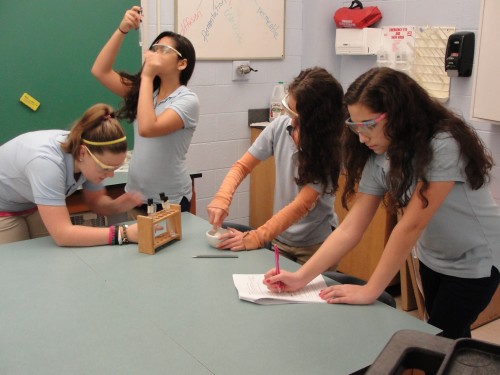
Co-Principal Investigators Vanessa Lugo, Nikki Markakis, Alexandra Pasamihalis, and Madison Pignatelli in Mrs. Fisher’s 8th grade class experiment with their reactants while completing their proposal.
Proposal Summary:
We want to determine if the eggshell disintegration rate in vinegar differs in the presence of gravity and microgravity so we can infer the damage acids will have against our teeth in space. We believe that the eggshells will dissolve quicker in space. Some facts that we learned from this research are that vinegar contains 3% acetic acid. Eggshells contain calcium carbonate. The two substances react and form carbon dioxide. Also the eggshells are like our teeth because they are both made out of stone-like minerals and mostly of calcium. The topic interests us
because eggshells and teeth both contain calcium carbonate and the reaction of acid to the eggshells may represent teeth and the affects of acids on them. We are hoping to learn the effect of the vinegar on the eggshells in comparison to teeth and food acids. The resulting information can help in the development of dental products in order to protect teeth from acidic foods while in space.
HONORABLE MENTION FINALISTS:
Iron and Bleach
Grade 8, Phifer Middle School
Co-Principal Investigators: Saniyah Mack, Kristina Mitchell, Hanna Nguyen, and Christiana Van
Collaborators: Alex Labenski, Vivian Huynh, and Jessica Tran
Teacher Facilitator: Amy Fisher, Science Teacher
Proposal Summary:
We want to know the effects of microgravity on iron reacting with bleach. Currently we know that, on Earth, iron rusts faster in bleach than in water, or by itself. We predict that the iron will rust faster on earth than in space. This is because oxygen helps iron rust. This topic is interesting for us because we just want to know what will happen. We are hoping to learn how fast the iron will rust. This can influence science by letting people know what can happen to iron in bleach. Scientists can use our research to do more experiments relating the two substances.
Blood Clotting in Microgravity
Grade 8, Phifer Middle School
Co-Principal Investigators: Name: Shala Anderson, Melanie Mansilla, Markita Scott, Laniah Henderson, and Melanie Mansilla
Teacher Facilitator: Francetta Johnson, Science Teacher
Proposal Summary:
Our group would like to investigate the following question, “How is the blood clotting process affected in space?” Blood clots are made when the blood does not circulate and it gets stuck in one place. Usually blood clots form to seal small cuts or breaks on blood vessel walls to stop bleeding. We hypothesize that blood will not clot in space, because of a lack of gravity. In this experiment we will analyze how the blood clotting process is affected by space. The following materials will be used in microgravity to test our hypothesis: synthetic blood type A and synthetic Antiserum B. Typically, the substance that mainly causes blood to clot is fibrin. However, we will use synthetic products to simulate the clotting process. There are also different things that cause blood clots, for examples peripheral venous disorder. This disorder is when blood clots form in veins. Also other ailments that can cause blood clots are infections, high blood pressure, strokes, varicose veins, and other vascular conditions.
13. New York City, New York – NEST+m [Mission 3b]
Jump to New York City’s Community Profile
SELECTED FOR FLIGHT:
Mammalian Milk in Microgravity
Grade 5, New Explorations into Science, Technology, and Math (NEST+M)
Co-Principal Investigators: Alexander Plossl and Lennie Ma
Collaborators: Cavan Miller, Clarisa Carillo, Dawson Hall, Elliot Leinweber, Felix Scaggiante, Georgia Podgainy, Hayley He, Isabella Serrano, Joseph Dell’Olio, Julien Saunier, Kamaya Gooding, Kathryn Galperin, Kaylyne Cruz, Kiara Bracero, Kunal Ghalawat, Laila Cruz, Maury Ahram, Mina Ekstrom, Nia Powell, Remmi Duplessis, Riley Sexton, Samantha Rapkiewicz, Sasha Roberts, Sebastian Delangle, Theodore Haegele, and Zubin Gell
Teacher Facilitator: Zach Vine, Science Teacher
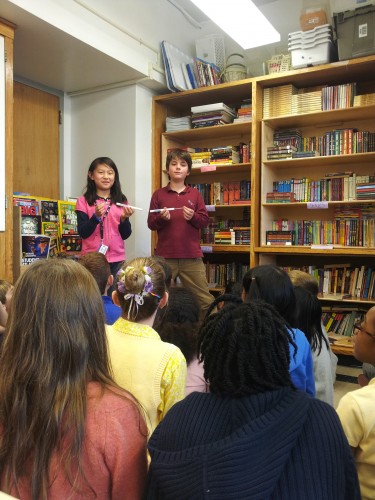
Principal Investigators Lennie Ma and Xander Plossl explain how to assemble a Type 2 FME mini-lab to their research collaborators in Zach Vine’s 5th grade classroom at New Explorations into Science, Technology and Math (NEST+m).
Proposal Summary:
Milk is a vital food source that mammals produce and depend on for the first years of their lives. Does milk spoil in microgravity the same way it does on Earth? Specifically, we are proposing an experiment that will answer the question: Does bacteria growth in milk happen differently in microgravity than it does on Earth? We are going to use a Type 2 Fluids Mixing Enclosure (FME). The main volume will contain 6m1 of distilled water and the large ampoule will contain 1.5ml of powdered whole milk. Once the FME is aboard the International Space Station (ISS), the powdered milk and water will be mixed together. Bacteria will begin to grow when the powdered milk is mixed with the distilled water. When the FME returns to Earth, we will examine the bacterial content of the milk that was in microgravity and compare it to the bacterial content of the milk that was part of our ground truth experiment. We will use a “bacterial examination of milk kit” purchased from Carolina Biological to help us conduct a standard plate count, a direct microscopic count, and a dye reductase test of the two milk samples. We hypothesize that the microgravity milk sample will grow bacteria differently than the milk sample from our ground truth experiment on Earth. Specifically, we believe that the microgravity milk sample will grow fewer bacteria than the ground truth experiment milk sample.
HONORABLE MENTION FINALISTS:
The Effect of Microgravity on the Action of Soda in Removing Rust
Grade 6, New Explorations into Science, Technology, and Math (NEST+M)
Co-Principal Investigators: Audrey Gatta, Blue Kaufman, and Isabelle Slater
Teacher Facilitator: Marvin Cadornigara, Science Teacher
Proposal Summary:
The aim of this experiment is to determine the effect of microgravity on the action of soda on rusty metals in space. Since soda is popularly known to remove rust on Earth, it could also remove rust in space. It is hypothesized that if gravity is decreased, then the action of soda in removing rust will also decrease. This experiment will need a Type 2 FME, 1.8 mL of Coca-Cola, three rusty iron strips each measuring 3cm x 0.5cm, and three rusty copper strips each measuring 3cm x 0.5cm. The average initial masses of the rusty iron strips and the rusty copper strips will be determined before flight. The iron and copper strips will be placed inside the FME Main Volume, while 1.8 mL of Coca-Cola will be placed inside the FME Long Ampoule. At the start of the investigation on space, the Long Ampoule will be cracked open and the FME will be shaken for about 10 seconds. The setup will be made to stand for the duration of the flight. The average final mass of both the iron and copper strips will be measured upon return to Earth. This experiment would be beneficial because if soda can remove rust on metal in space, than they could use it if metal gets rusty in space. The fact that it is considered safe for human consumption, soda does not pose threats to astronauts in space.
Growth of Staphylococcus Aureus in a Zero-Gravity Setting
Grade 8, New Explorations into Science, Technology, and Math (NEST+M)
Co-Principal Investigators: Esme Bleecker-Adams, Danielle Eisenman, Olivia Gallager, and Sophie Lieberman
Teacher Facilitator: Richard Sullivan, Science Teacher
Proposal Summary:
This experiment is designed to test whether or not the bacteria, Staphylococcus aureus, can grow in space, a setting of microgravity. Since oxygen is not a necessity for the growth of Staphylococcus aureus, the experiment will be conducted without oxygen. A similar, controlled experiment will be conducted on Earth, where the only difference, the independent variable, will be the presence of gravity. The data from the two experiments will be compared in order to see the differences (if there are any) between the Staphylococcus aureus growth in an environment with gravity and in an environment with a lack thereof. Both experiments will consist of combining Staphylococcus aureus and agar, a substance of gelatin consistency that is used as a growth medium and supplies nutrients to the bacteria. The bacterial growth will be observed and data will be recorded on the specified days.
The materials required will include the bacteria, the agar, and the proper experimental equipment for combining them. All variables should be the same for the two experiments (except for the independent variable). These include the lack of oxygen, the amount of Staphylococcus aureus to begin with, and the amount of agar, among others. The timing, as well, should correlate.
This is an opportunity to test a process that is certain to occur on Earth in the environment of outer space (although the experiment must still be carried out on Earth as well for direct comparison).
14. Guilford County, North Carolina [Mission 3b]
Jump to Guilford County’s Community Profile
SELECTED FOR FLIGHT:
Geotropism in Microgravity
Grade 9, STEM Early College at NC A&T
Co-Principal Investigators: Todd Baldwin and Emma Mengistu
Co-Investigators: Andrew Harvey and Zoe Kelley
Collaborators: Gage Carlisle and Erik Feldmann
Teacher Facilitator: Travis Wall, 9th Grade Biology Teacher
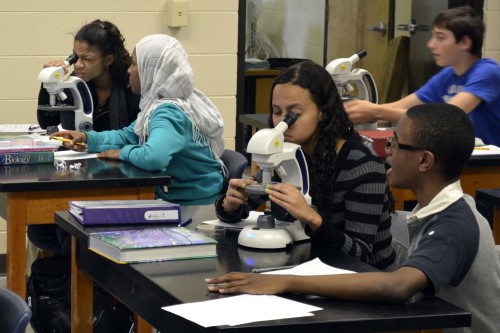
Students (from left to right) Kyler Mark, Areej Hussein, Emmanuela Mengistu, Peyton Echols and Vittorio Lagnerini, ninth-graders at The STEM Early College at NC A&T in Greensboro, N.C., use microscopes to compare the cellular structures of microscopic organisms.
Proposal Summary:
This project will determine whether geotropism in Allium Cepa, onions, is possible in a micro-gravitational environment. Geotropism is the process in which gravity effects the positioning of a plant. Science suggests that auxin concentrations are the possible driving force behind geotropism. Gravity helps a plant determine the directions up and down in order to position itself accordingly. No matter which position you put a plant in the roots and Cotyledon will always grow in opposite directions according to geotropism. However will the laws of geotropism apply in the micro-gravitational atmosphere in space? Will the plant still be able to position itself correctly so that its key formations will grow in opposite directions? We will be particularly focusing on the germination of the plant seeds and we will observe whether or not the roots and the Cotyledon of the plant will grow in opposite directions regardless of the lack of gravity acting on the plant. We will test this using water, oxygen, onion seeds and the Type 2 FME. We plan to germinate these onion seeds in space, by breaking the long ampoule on D-5 days there by mixing water and seeds and taking the seeds out of hibernation and start germination. When Type 2 FME returns to earth we will compare it with the germinating seeds here on earth. From this we will draw a conclusion on our focus.
HONORABLE MENTION FINALISTS:
Nematodes in Space
Grade 8, Southern Guilford Middle School
Principal Investigator: Taylor Tuttle
Co-Investigator: Maia Em
Collaborators: Alex K’briuh and Aaron Wilkerson
Teacher Facilitator: Deanna Wynn, Science Teacher
Proposal Summary:
In this project we will discover how Caenorhabditis elegans (Nematodes) react to microgravity. Our hypothesis is that the organism will survive in a microgravity environment. We think the microgravity could affect the rate at which the nematodes grow and live. The materials that we need in this project would be Caenorhabditis elegans live culture, Nematode Growth Agar and distilled water. In this project you will have to count the nematodes and see at what level their population begins. We are using a type 2 FME. Inside the Main Volume will be the Nematode Growth Agar and Caenorhabditis elegans live culture will be placed in the Long Ampoule. Once the tube arrives at the International Space Station, our team would like for the astronauts to break the Long Ampoule tube in order to release the Nematode culture into the Main Volume tube with the growth agar. Once the tube is broken on the first day, we would like for the astronauts not disturb it for the duration of the spaceflight.
Myco in Micro G
Grade 7 and 8, Mendenhall Middle School
Principal Investigator: Cameron Suber
Co-Investigator: Jordan Watts
Collaborator: Y’Ricki
Teacher Facilitator: Lenny Sue French, Science Teacher
Proposal Summary:
We are proposing an experiment that would test the growth of mycorrhizae fungus in microgravity. Mycorrhizae are beneficial root fungus. These fungi attach themselves to plant’s roots and are able to get water from up to a mile away back to the plant. This is a symbiotic relationship where the plant gets more access to water and minerals and the fungi exists on the glucose produced in the plant’s roots. We think that this could be a great help to NASA because it maximizes the resources in the area where it grows. On Mars the soil has been compared to the lava sands of Hawaii. If Mycorrhizae behaves the same in the presence of microgravity as it does here, plants could be successful in such soil. We will send fungi spores with molasses as it’s source of glucose into space and be able to see if it is able to reproduce there and send out tendrils to find sources of food.
15. Salem, Oregon [Mission 3b]
Jump to Salem’s Community Profile
SELECTED FOR FLIGHT:
How does bacterial growth and subsequent decay of enamel on pig teeth differ in a microgravity environment compared to on Earth?
Grade 9, West Salem High School
Co-Principal Investigators: Brooke Chuhlantseff, Deven Nipp, and Angela Mumford
Teacher Facilitator: Michael Lampert, Physics Teacher
Proposal Summary:
Our proposal is that we want to see if microgravity affects the bacterial growth and subsequent decay on pig teeth, and how it is different than on Earth. Ampule ‘A’ will contain S. Mutans, which we plan to obtain from Ward’s Natural Science Company. The S. Mutans that we will have are freeze dried and are a powdered substance. Ampule ‘B’ will contain formalin, which will be broken at the end of the experiment to kill and preserve the bacteria. The main volume of the FME is going to contain the shards of the pig’s teeth and Thioglycolate Broth (pH=7.1), which is a sugar nutrient source for the S. Mutans. The essential part of the experiment is that the astronauts will break the S. Mutans at A=0, which will release them into the nutrient broth and they will begin to grow throughout the solution. We also are going to coat 1/3 of the pig’s teeth with Paraffin so that the bacteria will not grow on the teeth and protect the teeth for comparison purposes. Another 1/3 will be coated in 5% sucrose agar. For the duration of the flight we are hoping that the bacteria are going to produce enough acid to decay the teeth. At D-2 the astronauts will break ampule ‘B’ and release the formalin, which will kill the bacteria so that when we receive our experiment here on Earth we can analyze the teeth. We have access to a microscope at the local university which we will use to look at the pitting of the teeth and compare the experiment to the one we will conduct on Earth.
HONORABLE MENTION FINALISTS:
Does the characteristics of slime mold differ finding food through a maze in a micro-gravity environment?
Grade 9, West Salem High School
Co-Principal Investigators: Joshua Spann and Conner Suderman
Teacher Facilitator: Michael Lampert, Physics Teacher
Proposal Summary:
Our experiment is to see the reaction of slime mold in a micro-gravity environment while finding its food through a maze in the FME. Slime mold is a single cell organism that has the ability to sense food and obtain it. In a gravity environment, like on Earth, slime mold is able to grow through complicated scenarios in order to obtain food. Our question is whether or not the slime mold will be able to cope with the micro-gravity environment and still be able to obtain its food. In this experiment, we will place the slime mold on one side of the FME and the food at the other. We will then place a series of barrier in between the mold and the food to resemble a maze. The maze will be composed of coffee straws which will test the slime mold’s ability to discern which straws are dead ends and what is the shortest course.
Why do more than 20% of astronauts report eye problems upon returning from a micro-gravity setting?
Grade 9, West Salem High School
Co-Principal Investigators: Gabe Buck, Cooper Frantz-Geddes, Chase Lakin, Marissa Meyer, and Joshua Warkentin
Teacher Facilitator: Michael Lampert, Physics Teacher
Proposal Summary:
We are attempting to contribute to the solution of why 20% of astronauts that returned from space reported a loss of, or alteration to their vision. To try to solve this we will be using a simple tube, which is our RME. In this, will be a circular wire with a membrane stretched across it, forming a seal. There will be water on one side, and air on the other. As it is in space, we believe that the membrane will allow some of the water to pass through the membrane trying to balance the fluids to both halves, and the membrane would expand. This would be a problem, because one’s eye has to maintain a healthy pressure. If one’s eye expands when one is in space, then that would just slightly lower the pressure. We believe that astronauts may lose their vision because of this slight alteration to the pressure and surface area of their eyes.
16. Willis, Texas [Mission 3a]
Jump to Willis’s Community Profile
SELECTED FOR FLIGHT:
Germination of Cabbage Seed
Grade 5, A.R. Turner, C.C. Hardy, and Parmley Elementary Schools
Co-Principal Investigators: Kalysta Gutierrez and Selma Nieniel
Co-Investigators: Danielle Pierce and Safira Reyes
Collaborators: Daniel Perez and Leiloni Zachary
Teacher Facilitators: Michelle Brown, Janet Lindsey, and Rachel Rockwell, Science Teachers
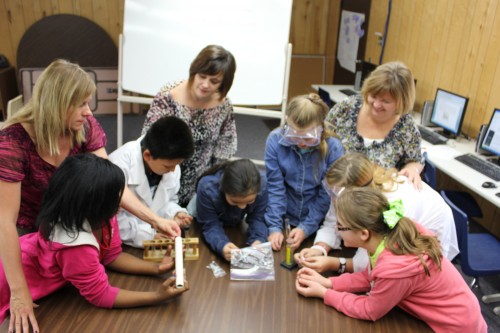
SSEP student flight team members and fifth grade science teachers begin setting up for their ground truth experiment.
Proposal Summary:
Our project is Savoy cabbage (Brassica oleracea var. sabauda) germinating in space. If the Brassica oleracea var. sabauda seed germinates in microgravity, it would be good for the astronauts because it would give them more nutrients and a source of fresh produce. We chose Savoy cabbage seeds for our experiment because it is rich in Thiamin, Calcium, Iron, Magnesium, Phosphorus and Potassium, and a very good source of Dietary Fiber, Vitamin C, Vitamin K, Vitamin B6, Folate and Manganese. We hypothesize that Savoy cabbage seeds will germinate in microgravity.
HONORABLE MENTION FINALISTS:
Does E.coli survive in cinnamon and apple juice in microgravity?
Grade 5, A.R. Turner, C.C. Hardy, and Parmley Elementary Schools
Co-Principal Investigators: Lainey McDonald and Sophia Meadows
Co-Investigators: Kiley Cheatham, Angellica Ochoa, Lily Utecht, and Keely Wilson
Teacher Facilitators: Michelle Brown, Janet Lindsey, and Rachel Rockwell, Science Teachers
Proposal Summary:
We found an interesting experiment that researchers at Kansas State conducted where cinnamon (a spice) was used to kill the E. coli bacteria in apple juice! An outbreak of this E. coli strain in 1996 was found in apple juice and killed a child after making many people sick. Escherichia coli, called E. coli, is a bacteria found in the digestive systems of animals. One specific strain can cause diarrhea, vomiting, and leave a person dehydrated. It can also damage the kidneys and walls of the small intestine in children. Part of the reason E. coli is so dangerous is because there is no effective cure for the infection. On Earth, the K-State experiment that used cinnamon killed the E. coli 99%. We want to know if cinnamon put in apple juice with E.coli will kill the same amount in microgravity the way it did here on Earth. While our project is in space, we will conduct the same experiment on Earth using a much smaller amount. When our project gets back we will look at the data and see if our hypothesis was correct. Maybe we can save an astronaut.
Will Germ-X kill E. coli in Microgravity?
Grade 5, A.R. Turner, C.C. Hardy, and Parmley Elementary Schools
Co-Principal Investigators: Kailee Tedder and Liz Vickery
Co-Investigators: Darius Johnson and Camden Scholer
Teacher Facilitators: Michelle Brown, Janet Lindsey, and Rachel Rockwell, Science Teachers
Proposal Summary:
Our team was curious about germs. During our research, we discovered Escherichia coli (E. coli). While researching, an ad popped up asking if we wanted to buy hand sanitizer. The ad left us thinking we should do an experiment involving E.coli and Germ-X. Our purpose is to see if hand sanitizer really kills 99.99% of germs as stated in the ad. Our hypothesis is that the hand sanitizer will kill at least half of the present E.coli germs. The reason we need to send our experiment into microgravity is that if hand sanitizer doesn’t kill the E. coli, then we need to find a substance that will kill it for the astronauts to have a safer environment. We hope that we will have this chance to remember for a lifetime. It would be an honor to be chosen.
17. Wise County, Virginia [Mission 3b]
Jump to Wise County’s Community Profile
SELECTED FOR FLIGHT:
Denaturation of the Protein Casein in Microgravity
Grade 12, Eastside High School
Co-Principal Investigators: Hunter Helbert and Aaron Sexton
Teacher Facilitator: Nellibrooke Fultz, Chemistry Teacher
Proposal Summary:
Using the reaction between milk and acetic acid, the protein casein will be extracted in a microgravity environment and tested to see if denaturation of this protein is occurring because of a lack of gravity. The main protein in homogenized cow’s milk is casein. The milk has been well mixed to prevent it from separating. At the normal pH of milk, the protein, called casein remains evenly dispersed in the solution. When an acid is added to the mixture, the pH drops and the casein can no longer stay dissolved, forming an insoluble mass of the protein.
We would like to perform this experiment between milk and acetic acid in a microgravity environment in a Fluid Mixing Enclosure or FME. The casein that is extracted in a microgravity environment will be compared to the casein extracted in a controlled environment on Earth to see if the lack of gravity caused denaturation of this protein. Several factors can cause the denaturation of a protein such as changes in pH and temperature. Could a lack of gravity also change the nature of this protein? We would like to answer this question by exposing the casein to a microgravity environment and examining the changes in the properties of this protein once it returns to Earth.
HONORABLE MENTION FINALISTS:
Activated Charcoal: Effective Water Filter in Space?
Grade 11 and 12, Central High School
Co-Principal Investigators: Zahra Ehtesham, Dakota Hayes, Elizabeth Hildebrand, Hunter Robinson, and Stephen Saucier
Teacher Facilitator: Dottie Dotson, STEM Teacher
Proposal Summary:
In the process of choosing an effective experiment to conduct, we considered multiple factors that would be beneficial to not only the astronauts but also the general public. After thorough investigation, we concluded that water filtration should be a top priority as we prepare for the future of space exploration. The use of activated charcoal, an easily accessible and cost efficient method of filtration, will help us achieve this goal. As the economical situation of many countries declines, activated charcoal could serve as a cheaper alternative for water filtration.
Activated charcoal is a sample of carbon that has been treated with oxygen. The oxygen causes the newly created charcoal to be highly porous. The frequent and sporadic pores allows for the liquids or gases passing through the charcoal to interact with the exposed carbon. Carbon naturally pulls impurities from these substances. In microgravity, it will be in a free-fall environment; this process will be more evenly distributed. Once the vial is shaken up, the mixture will stay agitated and will allow for the activated charcoal to filter the water more efficiently.
Absorption of Baby Diaper Polymer in Microgravity
Grade 12, Eastside High School
Co-Principal Investigators: April Eldridge and Lauren Riner
Teacher Facilitator: Nellibrooke Fultz, Chemistry Teacher
Proposal Summary:
Using one of the main ingredients in baby diapers, the absorption qualities of sodium polyacrylate in a microgravity environment will be examined. Sodium polyacrylate is a super absorbent polymer made from the monomer acrylic acid. Many polymers, such as those in trash bags and plastics, are hydrophobic, meaning they repel water. Sodium polyacrylate, however, is very hydrophilic, meaning it attracts water. The carboxylic acid groups in the polymer can hydrogen-bond to water molecules. Therefore, sodium polyacrylate can absorb many times its weight in water.
The absorption quality of sodium polyacrylate in a controlled environment on Earth will be compared to the absorption quality of sodium polyacrylate in a microgravity environment in space. The polarity of water and the process of osmosis are the two major factors at work during this absorption process. Understanding how fluids behave under different circumstances is important. For instance, sodium polyacrylate could be used in the process of cleaning up oil spills to absorb excess oil. Therefore, the question we would like to address is: does the polymer sodium polyacrylate absorb more water in a microgravity environment at a faster or slower rate than it does in a gravity environment on Earth?
